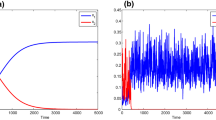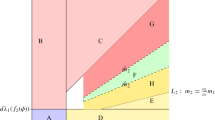Abstract
Classical chemostat models assume that competition is purely exploitative and mediated via a common, limiting and single resource. However, in laboratory experiments with pathogens related to the genetic disease Cystic Fibrosis, species specific properties of production, inhibition and consumption of a metabolic by-product, acetate, were found. These assumptions were implemented into a mathematical chemostat model which consists of four nonlinear ordinary differential equations describing two species competing for one limiting nutrient in an open system. We derive classical chemostat results and find that our basic model supports the competitive exclusion principle, the bistability of the system as well as stable coexistence. The analytical results are illustrated by numerical simulations performed with experimentally measured parameter values. As a variant of our basic model, mimicking testing of antibiotics for therapeutic treatments in mixed cultures instead of pure ones, we consider the introduction of a lethal inhibitor, which cannot be eliminated by one of the species and is selective for the stronger competitor. We discuss our theoretical results in relation to our experimental model system and find that simulations coincide with the qualitative behavior of the experimental result in the case where the metabolic by-product serves as a second carbon source for one of the species, but not the producer.
Similar content being viewed by others
References
Armstrong R.A., McGehee R. (1980) Competitive exclusion. Am. Nat. 115(2): 151–170
Bassler B.L. (1999) How bacteria talk to each other: regulation of gene expression by quorum sensing. Curr. Opin. Microbiol. 2, 582
Braselton J.P., Waltman P. (2001) A competition model with dynamically allocated inhibitor production. Math. Biosci. 173, 55–84
Butler G.J., Wolkowicz G.S.K. (1985) A mathematical model of the chemostat with a general class of functions describing nutrient uptake. SIAM J. Appl. Math. 45, 138–151
Chao L., Levin B.R. (1981) Structured habitats and the evolution of anticompetitor toxins in bacteria. Proc. Nat. Acad. Sci. USA 78, 6324–6328
Coppel W.A. (1965) Stability and Asymptotic Behavior of Differential Equations. D.C. Heath and Co., Boston
Diekmann O., Gyllenberg M., Metz J.A.J. (2003) Steady-state analysis of structured population models. Theor. Popul. Biol. 63, 309–338
Dockery J.D., Keener J.P. (2000) A mathematical model for quorum sensing in Pseudomonas aeruginosa. Bull. Math. Biol. 00, 1–22
Doebeli M. (2002) A model for the evolutionary dynamics of cross-feeding polymorphisms in microorganisms. Popul. Ecol. 44, 59–70
Ermentrout, B.: Simulating, Analyzing, and Animating Dynamical Systems: A Guide to XPPAUT for Researchers and Students. Society for Industrial and Applied Mathematics, (2002)
Freedman H.I., Xu. Y. (1993) Models of competition in the chemostat with instantaneous and delayed nutrient recycling. J. Math. Biol. 31, 513–527
Ghani M., Soothill J.S. (1997) Ceftazidime, gentamicin, and rifampicin, in combination, kill biofilm of mucoid Pseudomonas aeruginosa. Can. J. Microbiol. 43, 999–1004
Gopalsamy K. (1992) Stability and Oscillations in Delay Differential Equations of Population Dynamics. Kluwer, Dordrecht
S.R. Hansen, S.R., Hubbell, S.P.: Single-nutrient microbial competition: Qualitative agreement between experimental and theoretically forecast outcomes. Science 207(4438), 1491–1493 (1980)
Hardin G. (1960) The competitive exclusion principle. Science 131, 1292–1298
Hirsch M.W., Hanisch H., Gabriel J.-P. (1985) Differential equation models of some parasitic infections: methods for the study of asymptotic behavior. Comm. Pure Appl. Math. 38, 733–753
Hsu S.B. (1978) Limiting behavior for competing species. SIAM J. Appl. Math. 34, 760–763
Hsu S.B., Hubbell S.P., Waltman P. (1977) A mathematical theory for single-nutrient competition in continuous cultures of micro-organisms. SIAM J. Appl. Math. 32(2): 366–383
Hsu S.B., Li Y.-S., Waltman P. (2000) Competition in the presence of a lethal external inhibitor. Math. Biosci. 167(2): 177–199
Hsu S.B., Luo T.-K., Waltman P. (1995) Competition between plasmid-bearing and plasmid-free organisms in a chemostat with an inhibitor. J. Math. Biol. 34, 225–238
Hsu S.B., Waltman P. (1991) Analysis of a model of two competitors in a chemostat with an external inhibitor. SIAM J. Appl. Math. 52(2): 528–541
Hsu S.B., Waltman P. (1997) Competition between plasmid-bearing and plasmid-free organisms in selective media. Chem. Eng. Sci. 52(1): 23–35
Hsu S.B., Waltman P. (1998) Competition in the chemostat when one competitor produces a toxin. Jpn J. Indust. Appl. Math. 15, 471–490
Hsu S.B., Waltman P. (2002) A model of the effect of anti-competitor toxins on plasmid-bearing, plasmid-free competition. Taiwanese J. Mathematics 6, 135–155
S.B., Hsu, Waltman, P.: A survey of mathematical models of competition with an inhibitor. Math. Biosci. 187, 53–91 (2004)
Hutchinson G.E. (1961) The paradox of the plankton. Am. Nat. 95, 137–145
Lenski R.E., Hattingh S.E. (1986) Coexistence of two competitors on one resource and one inhibitor: A chemostat model based on bacteria and antibiotics. J. Theor. Biol. 122, 83–96
Li B. (1998) Global asymptotic behavior of the chemostat: General response functions and different removal rate. SIAM J. Appl. Math. 59(2): 411–422
Lu Z., Hadeler K.P. (1998) Model of plasmid-bearing, plasmid-free competition in the chemostat with nutrient recycling and an inhibitor. Math. Biosci. 148, 147–159
Luo T.K., Hsu S.B. (1995) Global analysis of a model of plasmid-bearing, plasmid-free competition in a chemostat with inhibitons. J. Math. Biol. 34, 41–76
Madigan, M.T. Martinko, J.M., Parker, J.: Brock Biology of Microorganisms. Prentice Hall Englewood Cliffs, (2003)
Marsh P.D., Bowden G.H.W. (2000) Microbial community interactions in biofilms. In: Allison D.G., Gilbert P., Lappin-Scott H.M., Wilson M. (eds) Community Structure and Co-operation in Biofilms. Press Syndicate of the University of Cambridge, Cambridge, pp. 167–198
Passarge J., Huisman J.(2002) Competition in well-mixed habitats: From competitive exclusion to competitive chaos. In: Sommer U., Worm B. ed, Competition and Coexistence Ecological Studies., vol 161, Springer, Berlin Heidelberg New York, pp. 7–42
Reeves G.T., Narang A., Pilyugin S.S. (2004) Growth of mixed cultures on mixtures of substitutable substrates: the operating diagram for a structured model. J. Theor. Biol. 226, 143–157
Riedel K., et al. (2001) N-acylhomoserine-lactone-mediated communication between Pseudomonas aeruginosa and Burkholderia cepacia in mixed biofilms. Microbiology 147, 3249–3262
Ruan S., He X.-Z. Global stability in chemostat-type competition models with nutrient recycling. SIAM J. Appl. Math. 58(1): 170–198 (1998) A correction can be found online at http://www.math.miami.edu/∼ruan/publications.html
Sardonini C.A., DiBiasio D. (1987) A model for growth of Saccharomyces cerevisiae containing a recombinant plasmid in selective media. Biotechnol. Bioeng. 29, 469–475
Schmidt, J.K., König, B., Reichl, U.: Characterization of a three bacteria mixed culture in a chemostat: Evaluation and application of a quantitative Terminal-Restriction Fragment Polymorphism (T-RFLP) analysis for absolute and species specific cell enumeration. Biotechnol. Bioeng. (2006) (submitted)
Smith H.L., Waltman P. (1995) The Theory of the Chemostat. Cambridge University Press, Cambridge
Turner P.E., Souza V., Lenski R.E. (1996) Test of ecological mechanisms promoting the stable coexistence of two bacterial genotypes. Ecology 77(7): 2119–2129
Wolkowicz G.S.K., Lu Z. (1992) Global dynamics of a mathematical model of competition in the chemostat: General response functions and differential death rates. SIAM J. Appl. Math. 52(1): 222–233
Wolkowicz G.S.K., Zhiqi L. (1998) Direct interference on competition in a chemostat. J. Biomath. 13(3): 282–291
Author information
Authors and Affiliations
Corresponding author
Additional information
Julia Heßeler and Julia K. Schmidt contributed equally to this work
Rights and permissions
About this article
Cite this article
Heßeler, J., Schmidt, J.K., Reichl, U. et al. Coexistence in the chemostat as a result of metabolic by-products. J. Math. Biol. 53, 556–584 (2006). https://doi.org/10.1007/s00285-006-0012-3
Received:
Revised:
Published:
Issue Date:
DOI: https://doi.org/10.1007/s00285-006-0012-3




